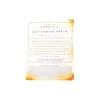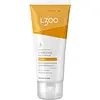What's inside
What's inside
 Key Ingredients
Key Ingredients

 Benefits
Benefits

 Concerns
Concerns

 Ingredients Side-by-side
Ingredients Side-by-side

Butyl Methoxydibenzoylmethane 3%
UV AbsorberEthylhexyl Methoxycinnamate 75%
UV AbsorberEthylhexyl Salicylate 4%
UV AbsorberBenzophenone-3 5%
UV AbsorberWater
Skin ConditioningSteareth-2
EmulsifyingHeptyl Undecylenate
EmollientEthylhexyl Triazone
UV AbsorberDimethicone
EmollientSteareth-21
CleansingOctyldodecanol
EmollientStearic Acid
CleansingC12-15 Alkyl Benzoate
AntimicrobialBis-Ethylhexyloxyphenol Methoxyphenyl Triazine
Skin ConditioningMethylene Bis-Benzotriazolyl Tetramethylbutylphenol
UV FilterPEG-30 Dipolyhydroxystearate
EmulsifyingRubus Chamaemorus Seed Extract
Skin ConditioningRubus Chamaemorus Seed Oil
Skin ConditioningButylene Glycol
HumectantPhenoxyethanol
PreservativeCetearyl Alcohol
EmollientTocopheryl Acetate
AntioxidantCaprylyl Glycol
EmollientPPG-15 Stearyl Ether
EmollientMica
Cosmetic ColorantCI 77891
Cosmetic ColorantCetearyl Dimethicone Crosspolymer
Panthenol
Skin ConditioningLecithin
EmollientDecyl Glucoside
CleansingAcrylates/C10-30 Alkyl Acrylate Crosspolymer
Emulsion StabilisingXanthan Gum
EmulsifyingMagnesium Ascorbyl Phosphate
AntioxidantSorbic Acid
PreservativePEG-8
HumectantDisodium EDTA
Sodium Hydroxide
BufferingTocopherol
AntioxidantSodium Lactate
BufferingLactic Acid
BufferingGlycerin
HumectantSerine
MaskingSorbitol
HumectantTea-Lactate
HumectantUrea
BufferingPropylene Glycol
HumectantAscorbyl Palmitate
AntioxidantSodium Chloride
MaskingChondrus Crispus
MaskingAscorbic Acid
AntioxidantCitric Acid
BufferingAllantoin
Skin ConditioningHippophae Rhamnoides Oil
EmollientRosmarinus Officinalis Leaf Extract
AntimicrobialHelianthus Annuus Seed Oil
EmollientCitral
PerfumingGeraniol
PerfumingHexyl Cinnamal
PerfumingLimonene
PerfumingLinalool
PerfumingButylphenyl Methylpropional
PerfumingParfum
MaskingButyl Methoxydibenzoylmethane 3%, Ethylhexyl Methoxycinnamate 75%, Ethylhexyl Salicylate 4%, Benzophenone-3 5%, Water, Steareth-2, Heptyl Undecylenate, Ethylhexyl Triazone, Dimethicone, Steareth-21, Octyldodecanol, Stearic Acid, C12-15 Alkyl Benzoate, Bis-Ethylhexyloxyphenol Methoxyphenyl Triazine, Methylene Bis-Benzotriazolyl Tetramethylbutylphenol, PEG-30 Dipolyhydroxystearate, Rubus Chamaemorus Seed Extract, Rubus Chamaemorus Seed Oil, Butylene Glycol, Phenoxyethanol, Cetearyl Alcohol, Tocopheryl Acetate, Caprylyl Glycol, PPG-15 Stearyl Ether, Mica, CI 77891, Cetearyl Dimethicone Crosspolymer, Panthenol, Lecithin, Decyl Glucoside, Acrylates/C10-30 Alkyl Acrylate Crosspolymer, Xanthan Gum, Magnesium Ascorbyl Phosphate, Sorbic Acid, PEG-8, Disodium EDTA, Sodium Hydroxide, Tocopherol, Sodium Lactate, Lactic Acid, Glycerin, Serine, Sorbitol, Tea-Lactate, Urea, Propylene Glycol, Ascorbyl Palmitate, Sodium Chloride, Chondrus Crispus, Ascorbic Acid, Citric Acid, Allantoin, Hippophae Rhamnoides Oil, Rosmarinus Officinalis Leaf Extract, Helianthus Annuus Seed Oil, Citral, Geraniol, Hexyl Cinnamal, Limonene, Linalool, Butylphenyl Methylpropional, Parfum
Water
Skin ConditioningGlycerin
HumectantButyrospermum Parkii Butter
Skin ConditioningBetaine
HumectantCetyl Alcohol
EmollientPropanediol
SolventBis-PEG/PPG-16/16 PEG/PPG-16/16 Dimethicone
EmollientPanthenol
Skin ConditioningAscorbyl Glucoside
AntioxidantXanthan Gum
EmulsifyingTocopheryl Acetate
AntioxidantTocopherol
AntioxidantHippophae Rhamnoides Fruit Juice
Skin ConditioningCitrus Grandis Fruit Extract
AstringentDimethicone
EmollientSodium Citrate
BufferingAcrylates/C10-30 Alkyl Acrylate Crosspolymer
Emulsion StabilisingCaprylic/Capric Triglyceride
MaskingPotassium Hydrolyzed Polygamma-Glutamate
Ethylhexylglycerin
Skin ConditioningTetrasodium Iminodisuccinate
Pentaerythrityl Tetra-Di-T-Butyl Hydroxyhydrocinnamate
AntioxidantSodium Hydroxide
BufferingCitric Acid
BufferingPhenoxyethanol
PreservativeSodium Benzoate
MaskingPotassium Sorbate
PreservativeWater, Glycerin, Butyrospermum Parkii Butter, Betaine, Cetyl Alcohol, Propanediol, Bis-PEG/PPG-16/16 PEG/PPG-16/16 Dimethicone, Panthenol, Ascorbyl Glucoside, Xanthan Gum, Tocopheryl Acetate, Tocopherol, Hippophae Rhamnoides Fruit Juice, Citrus Grandis Fruit Extract, Dimethicone, Sodium Citrate, Acrylates/C10-30 Alkyl Acrylate Crosspolymer, Caprylic/Capric Triglyceride, Potassium Hydrolyzed Polygamma-Glutamate, Ethylhexylglycerin, Tetrasodium Iminodisuccinate, Pentaerythrityl Tetra-Di-T-Butyl Hydroxyhydrocinnamate, Sodium Hydroxide, Citric Acid, Phenoxyethanol, Sodium Benzoate, Potassium Sorbate
Ingredients Explained
These ingredients are found in both products.
Ingredients higher up in an ingredient list are typically present in a larger amount.
Acrylates/C10-30 Alkyl Acrylate Crosspolymer is a synthetic polymer. It is used to thicken and improve the texture of products. Due to its properties, it can prevent water and oil ingredients from separating.
Citric Acid is an alpha hydroxy acid (AHA) naturally found in citrus fruits like oranges, lemons, and limes.
Like other AHAs, citric acid can exfoliate skin by breaking down the bonds that hold dead skin cells together. This helps reveal smoother and brighter skin underneath.
However, this exfoliating effect only happens at high concentrations (20%) which can be hard to find in cosmetic products.
Due to this, citric acid is usually included in small amounts as a pH adjuster. This helps keep products slightly more acidic and compatible with skin's natural pH.
In skincare formulas, citric acid can:
While it can provide some skin benefits, research shows lactic acid and glycolic acid are generally more effective and less irritating exfoliants.
Most citric acid used in skincare today is made by fermenting sugars (usually from molasses). This synthetic version is identical to the natural citrus form but easier to stabilize and use in formulations.
Read more about some other popular AHA's here:
Learn more about Citric AcidDimethicone is a type of synthetic silicone created from natural materials such as quartz.
What it does:
Dimethicone comes in different viscosities:
Depending on the viscosity, dimethicone has different properties.
Ingredients lists don't always show which type is used, so we recommend reaching out to the brand if you have questions about the viscosity.
This ingredient is unlikely to cause irritation because it does not get absorbed into skin. However, people with silicone allergies should be careful about using this ingredient.
Note: Dimethicone may contribute to pilling. This is because it is not oil or water soluble, so pilling may occur when layered with products. When mixed with heavy oils in a formula, the outcome is also quite greasy.
Learn more about DimethiconeGlycerin is already naturally found in your skin. It helps moisturize and protect your skin.
A study from 2016 found glycerin to be more effective as a humectant than AHAs and hyaluronic acid.
As a humectant, it helps the skin stay hydrated by pulling moisture to your skin. The low molecular weight of glycerin allows it to pull moisture into the deeper layers of your skin.
Hydrated skin improves your skin barrier; Your skin barrier helps protect against irritants and bacteria.
Glycerin has also been found to have antimicrobial and antiviral properties. Due to these properties, glycerin is often used in wound and burn treatments.
In cosmetics, glycerin is usually derived from plants such as soybean or palm. However, it can also be sourced from animals, such as tallow or animal fat.
This ingredient is organic, colorless, odorless, and non-toxic.
Glycerin is the name for this ingredient in American English. British English uses Glycerol/Glycerine.
Learn more about GlycerinPanthenol is a common ingredient that helps hydrate and soothe the skin. It is found naturally in our skin and hair.
There are two forms of panthenol: D and L.
D-panthenol is also known as dexpanthenol. Most cosmetics use dexpanthenol or a mixture of D and L-panthenol.
Panthenol is famous due to its ability to go deeper into the skin's layers. Using this ingredient has numerous pros (and no cons):
Like hyaluronic acid, panthenol is a humectant. Humectants are able to bind and hold large amounts of water to keep skin hydrated.
This ingredient works well for wound healing. It works by increasing tissue in the wound and helps close open wounds.
Once oxidized, panthenol converts to pantothenic acid. Panthothenic acid is found in all living cells.
This ingredient is also referred to as pro-vitamin B5.
Learn more about PanthenolPhenoxyethanol is a preservative that has germicide, antimicrobial, and aromatic properties. Studies show that phenoxyethanol can prevent microbial growth. By itself, it has a scent that is similar to that of a rose.
It's often used in formulations along with Caprylyl Glycol to preserve the shelf life of products.
Sodium Hydroxide is also known as lye or caustic soda. It is used to adjust the pH of products; many ingredients require a specific pH to be effective.
In small amounts, sodium hydroxide is considered safe to use. However, large amounts may cause chemical burns due to its high alkaline.
Your skin has a natural pH and acid mantle. This acid mantle helps prevent harmful bacteria from breaking through. The acid mantle also helps keep your skin hydrated.
"Alkaline" refers to a high pH level. A low pH level would be considered acidic.
Learn more about Sodium HydroxideTocopherol (also known as Vitamin E) is a common antioxidant used to help protect the skin from free-radicals and strengthen the skin barrier. It's also fat soluble - this means our skin is great at absorbing it.
Vitamin E also helps keep your natural skin lipids healthy. Your lipid skin barrier naturally consists of lipids, ceramides, and fatty acids. Vitamin E offers extra protection for your skin’s lipid barrier, keeping your skin healthy and nourished.
Another benefit is a bit of UV protection. Vitamin E helps reduce the damage caused by UVB rays. (It should not replace your sunscreen). Combining it with Vitamin C can decrease sunburned cells and hyperpigmentation after UV exposure.
You might have noticed Vitamin E + C often paired together. This is because it is great at stabilizing Vitamin C. Using the two together helps increase the effectiveness of both ingredients.
There are often claims that Vitamin E can reduce/prevent scarring, but these claims haven't been confirmed by scientific research.
Learn more about TocopherolTocopheryl Acetate is AKA Vitamin E. It is an antioxidant and protects your skin from free radicals. Free radicals damage the skin by breaking down collagen.
One study found using Tocopheryl Acetate with Vitamin C decreased the number of sunburned cells.
Tocopheryl Acetate is commonly found in both skincare and dietary supplements.
Learn more about Tocopheryl AcetateWater. It's the most common cosmetic ingredient of all. You'll usually see it at the top of ingredient lists, meaning that it makes up the largest part of the product.
So why is it so popular? Water most often acts as a solvent - this means that it helps dissolve other ingredients into the formulation.
You'll also recognize water as that liquid we all need to stay alive. If you see this, drink a glass of water. Stay hydrated!
Learn more about WaterXanthan gum is used as a stabilizer and thickener within cosmetic products. It helps give products a sticky, thick feeling - preventing them from being too runny.
On the technical side of things, xanthan gum is a polysaccharide - a combination consisting of multiple sugar molecules bonded together.
Xanthan gum is a pretty common and great ingredient. It is a natural, non-toxic, non-irritating ingredient that is also commonly used in food products.
Learn more about Xanthan Gum